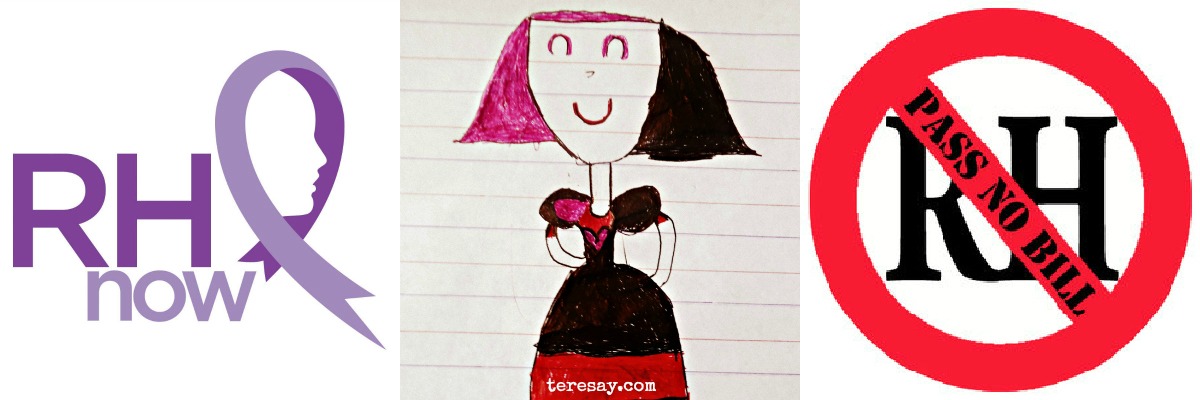RH Bill in the Philippines and the Women Caught in Between

The Reproductive Health Bill or the RH Bill known as House Bill 4244 in the Philippines appear to have finally made its way out of the woods after its recent simultaneous “triumph” both in the Lower House and the Senate. Proponents of the program have been showing much jubilation while those against it see the bill’s passing as one of the saddest things that could happen for their cause. Caught in between, is the Filipina who has no desire to go against her faith but would like to have access to suitable female reproductive health care.
The History of RH Bill in the Philippines
The RH Bill traces its roots to the Declaration on Population signed in 1967 by several countries including the Philippines. This declaration has identified the population problem as a key element to be considered in planning for long-term economic development. The Population Commission was established as a result of this for the purpose of decreasing family size. The United States Agency for International Development or USAID has been shouldering the big bulk of the cost of contraceptives allotted for the country. USAID started phasing out its program of providing free contraceptives to different countries in the year 2003.
The first RH bill was filed 14 years ago during the 8th Congress. It has encountered strong opposition mainly from the Roman Catholic Church. This bill which seeks to make available natural and artificial contraception, among others, found support in the 15th Congress. The two chambers of Congress have already formed a bicameral committee for the consolidation of the two versions. The President is likewise expected to sign this into law soon once the consolidated version has been ratified.
Salient Points of the Passed RH Bill
There were at least six prior house bills that were consolidated to form House Bill 4244 which is “An Act Providing for a Comprehensive Policy on Responsible Parenthood, Reproductive Health, and Population and Development, and for Other Purposes”. The full text of the Bill can be seen here. It is known as The Responsible Parenthood, Reproductive Health and Population and Development Act of 2011 or simply The Reproductive Health Bill.
The proponents of the Bill put forward several reasons for laying the foundation of the bill. Some of which include public access to reproductive health services, better maternal care, responsible parenthood, and youth education on issues related to sexual and reproductive health. These very reasons however, are causing vehement opposition from the Catholic Church.
The Opposition
Within this seemingly noble purpose lies the basis of the opposition. The use of the taxpayers’ money to fund the distribution of contraceptives through local and national government agencies, concerns about the very thin line that separates responsible parenthood and population control, the questioned wisdom in providing mandatory RH education to the youth while providing access to contraceptives, and the fear that the use of artificial means of contraception will be presented as a better option for better maternal care than natural means in spite of assurance of balanced presentation and freedom of choice – are just some of the reasons why The Catholic Church continues to oppose the RH Bill. This opposition has prompted some quarters to say that the Church has been simply imposing its influence on its followers without regard to their welfare.
Why does the Catholic Church zero in on the RH Bill when it is a fact that contraceptives are commercially available almost everywhere without fear of sanction from the government nor the Church? The Church’s answer is quite simple. Enacting the bill into a law provides it undue advantage in logistics and funding which can result in grossly imbalanced presentation of facts, giving rise to the possibility that it will hurt the very same women it has vowed to protect. Other countries who have gone on with their plans to control their population appear to be reconsidering and enacting changes that will tend to relax original provisions.
My Say
The free distribution of contraceptives or giving the “marginalized” women access to it does not inspire much confidence in me that a solution to our problems will be reached. I just cannot help but wonder what would happen if the same amount of funding and efforts will simultaneously be given in support of creating real jobs for Filipinos, jobs that are not merely good to look at in statistics but jobs that can provide self-worth to anyone interested in improving their lives. I wonder which program will succeed in improving the lives of Filipino men and women alike.
I believe I have heard the best reaction so far to this controversial passage of the RH Bill from one Catholic priest. He calmly says that the passage of the bill is not the end but rather a signal for them to continue explaining to the public what it is really all about. There is no doubt that the government will continue to work on their stand as well. It is anybody’s guess if the two formidable institutions can work together towards the betterment of Filipinos. The RH Bill in the Philippines has clearly caught the women in between for no one really knows where this path will take us.
Addendum:
President Benigno Aquino III signed the RH Bill into law last December 21, 2012 without much fanfare. The RH Bill is now known as Republic Act 10354. Acting as the lead agency for this program is the Department of Health.













Rcel
The population in Philippines needs to be controlled. The country is so densed now. I am Pro-RH Bill. It might not solve the problems the Philippines is facing but when people are educated about population education, it will help to eradicate poverty because there will not be more and more people who will be born to poor families who didn’t have knowledge on sex, population education and responsible choices and how uncontrolled population will cause more hardship on them..
Teresa Martinez
I agree with you on the need to educate so I hope that the kind of education that will be offered by the government based on the RH Bill will inform women of the possible side effects of invasive contraceptives as well so they will not end up worse off than before the RH Bill was put in place.
jheylo
i think continues awareness program teaching every people in the community will help. People have to learn the having lots of children is not good especially when they can’t even afford to feed their kids anymore. Usually those less fortunate people are the ones that have lots of children.
Teresa Martinez
There is no question that it is not proper to have more children than a couple can actually provide for. The point of contention really here is just the means of doing it because of different beliefs ans principles.
jared's mum
if only it will lessen little children going out on the streets to be for food and decrease the rate of population increase in our country, i am all for RH Law. But sadly, the discipline and education on reproduction is really not something to pass as law, as each individual actually has to be responsible enough to consider birth spacing, family planning + all that stuff.
the government could’ve put the money, time + effort spent on this bill on a much productive activity that would benefit each and every Filipino…
Teresa Martinez
It is ironic that regardless of religious beliefs, people are generally in agreement that there is an existing problem where population is an issue, in the same manner as corruption and lack of jobs are. Both sides in the RH Bill have valid points and it is my hope that they can join together and help find a real solution to the problem. I just find it incredulous how some people project their views by either lambasting the Catholic Church or providing reasons to disapprove of the RH Bill by giving senseless reasons. They do not serve the cause of any of the camps when a religion is disrespected or when Catholic lawmakers are unable to fully explain their stand.
joy
i’ve heard this bill were being passed already. let see how its going to work and if its effective…hmmmm.
Teresa Martinez
In the interest of the Filipino people, most especially the women, let us all hope that there is something beneficial that will come out of this highly controversial and divisive topic.
Chubskulit Rose
I declined taking contraceptives when my OBGyne asked me if I want some because it is against my belief but if it will help the Philippines, I’ll support it. This will benefit those women who live in remote areas who doesn’t have any family planning at all. I feel bad for those kids that doesn’t have any clear path for their future because parents can’t even afford to give them a decent education .
Teresa Martinez
One of the gray areas of the RH Bill is how the program is to be implemented. If it is carried out with due respect to the woman involved by providing the pros and cons, they will be more able to decide wisely. I am just wary of a scenario where women will be led to believe that artificial contraception is the only way to go because it is the easiest as compared to the Catholic option which is to exercise control over sexual urges to time contraception with natural biological processes. I hope every Filipina will be given the choice which you had. The right to choice starts from the time when a woman decides to participate in a sexual relationship and not after where terminating a life comes into play.
Tess Torrecampo (@Blogandme)
It is high time(long been overdue) for us Filipinos to take few steps away. We have a fast growing population, every body should be aware of the implication of this on our economy. Church should definitely separate itself from the government, c’mon move on.
Teresa Martinez
The population is seen as a problem because of the mounting needs that can no longer be supported by the government thus it is true that there are long overdue actions that should be done. I have to respectfully disagree that moving on can be accomplished by simply making the RH Bill into law. The progress we all aspire for requires a more comprehensive overhaul of values and priorities.
Rom Ireton
the government can still support the people… they’ll just have to pass laws that will distribute the wealth of the country better… a single family having 10 houses is disgusting when thousands of families don’t even have any roof on their heads…
Teresa Martinez
Based on the big amounts of money supposedly being given to government officials as bonuses, it appears that government can actually afford to support the people except that the funds fail to to reach those that need them most. I agree with you that seeing some families wallowing in wealth by having so many houses under their name when others do not even have one piece of roofing over their heads is disgusting. In fact, it is immoral.
jo-ann
I am not pro or against RH bill, for me whatever it is that will make our country progressive I’ll go for it.
Teresa Martinez
I believe all of us are one in hoping for a progressive Philippines, we just need to be careful in getting there.
Adobotech
It is time that this bill is pass! This will not just benefits women but also the community and the over population we have.
Teresa Martinez
I am looking forward to seeing real benefits especially to women who might not be fully informed of the possible negative effects of taking artificial contraceptives particularly those which are invasive to the body.
Kenneth Ravida
I am not in full support of RH bill but I hate the meddling of the Catholic church, Let the government do their job, I believe in the freedom of choice.
Teresa Martinez
The Catholic Church has been lambasted over and over again for its stand against the RH Bill with its proposed provisions. Many fail to realize that the Catholic Church is doing that because the issues at hand are against its core beliefs so if it will keep quiet at this time, it ceases to represent what it stands for. Without touching on the merits of the religion itself and other religions for that matter which is always highly debatable and controversial, it has to be understood that each one of us has the right to fight for what we believe in.
It just so happened that Catholics still comprise the majority of Filipinos that is why what the Catholic priests preach on the pulpit can be seen by some as meddling in politics because of the possible effect. In our realities today, separation of state and church seems to be used based on caprice, to be called upon or shunned depending on which will serve personal purposes. Government tells the Church to stay away from politics and then courts different Churches come election season.
jsncruz
Good, honest commentary. I am a supporter of the RH Bill. While I agree that it’s not a complete solution to our country’s woes, I must say it never posited itself as such. It’s a GREAT FIRST STEP into creating a better generation of a better Philippines, in my opinion. While the Church opposes it for all its worth, it has neither given an alternative nor offered to take up the burden of the cross, pun very much intended. Just my opinion 🙂
Teresa Martinez
In a way, I support the bill as well BUT ONLY in so far as its intention of providing suitable reproductive heath care for women. There are so many questionable provisions included which has to be ironed out so that the positive intention of the bill will not be diluted.
falz
I support the bill, if you look at many families, they cannot control how many children that they will raise up, the end result, they can’t provide for the basic needs for their children.
Teresa Martinez
Education of spouses and families is the key to a comprehensive change. I have my personal reservations about this particular RH Bill.
Yaniconquistadora (@YaniMetrado)
We can never tell when will this issue end. What is important is that we must stand our ground and help improve the lives of the Filipino people.
Teresa Martinez
As we look for ways in improving our lives, we will be forced to face various issues that would require us to make decisions so it would be best if we remain focused on what is essential and acceptable to us based on what we believe in. Each individual has his/her own set of values which is a product of upbringing, culture, and personal experiences.
special education philippines
This is a good and timely post as this is already a monumental part of our history as Filipinos. Your research in making this post will help generations from now in learning what happened during the passing of the RH Bill. I hope you can also add links and videos to further maximize the use of multimedia. 🙂
Teresa Martinez
Thanks, will try to work on your suggestions.
lovemindanao
i fully support the bill. Ballooning population is a major problem we have. I we just look at the nations that are advanced they managed to control their population . easier to provide services needed by their citizen…
Teresa Martinez
It is quite ironic how countries who have effectively controlled their population are now facing their own problems like an aging population. It is really difficult to strike the right balance with regards to population and I think this issue will rage on for quite some time before it settles, if at all.